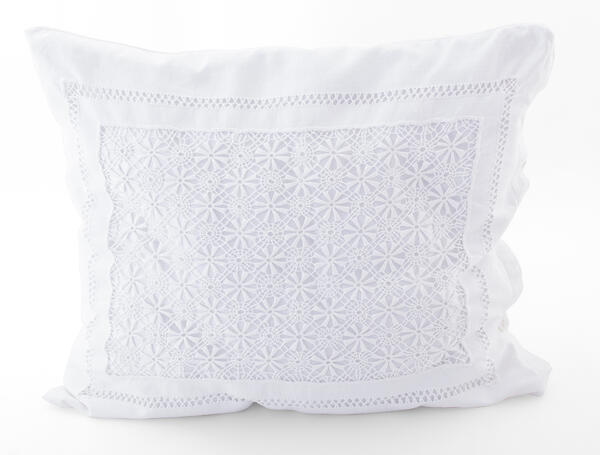The museum collection features a rectangular pillowcase. Its front side is decorated with filet embroidery. A complex pattern in the form of roses is made with white threads on a piece of linen cloth.
The original was donated to the museum by Claudia Pavlovna Anokhina, who lived in the Moscow apartment of Vladimir Ilyich Lenin’s elder sister, Anna Ilyinichna Ulyanova, on 9 Manezhnaya Street. Claudia Pavlovna was an old acquaintance of Anna Ilyinichna and the wife of one of her pupils. In 1968, the collection was replenished with several memorabilia that belonged to Anna Ilyinichna and her family: a case for pince-nez, crystal and wooden salt cellars, a tureen, a tray for a samovar and the original pillowcase with filet lace.
Filet embroidery is a type of embroidery on a knotted net. Traditionally, in Russia, there were two ways of making the base for the net. In the first case, extra threads were pulled out of the canvas. In the second, which is faster and more convenient, the base was knitted or woven using a shuttle, needle or crochet. Bobbins were also used — special tools in the form of a coil with a handle, on which threads were wound to make lace.
Many historians agree that the roots of filet embroidery are closely related to the art of weaving fishing nets. Over time, this technique began to be used for interior items. It was used to make tablecloths, curtains, napkins, as well as lace cloths and braid, which decorated table linen.
Usually, the craftswomen mastered several techniques of filet embroidery. Due to the simplicity of its execution, any schemes and patterns for monochrome cross-stitch could be used.
The girls in the Ulyanov family were taught needlework by their mother, Maria Alexandrovna, who also became their first teacher and mentor.
“My mother gave me a big ball of red wool and a
crochet hook <…> I’m hemming a handkerchief, this is still my first
job, and it isn’t going particularly well. Still, I pick with a needle, sitting next to my mother, who is also busy
with work. And suddenly, when I come to the end, there is a piece of chocolate
wrapped in paper pinned to the corner of the handkerchief. I’m amazed: where did it come from? <…> My mother managed to do her trick so cleverly that the appearance of
this piece of chocolate remained a mystery to me. We easily got used to work
due to the fact that our mother had a skillful pedagogical approach to raising
children, a lot of tact and zero nervousness, sharpness or shouting at
children, ” recalled Lenin’s younger sister Maria Ilyinichna Ulyanova.





